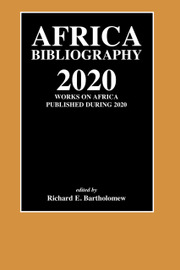With the publication of this, the 2012 volume, the online Africa Bibliography will hold just over 88,000 entries, dating from between 1990 and 2012. Nearly 55,000 additional archival entries remain in production, which together promise to enrich the online Bibliography's coverage of the period 1990–96 as well as take it back to 1984 and the origins of the print series. The transition of these records from the printed page to the online database involves a painstaking process – with each entry scanned, copyedited and individually tagged to support searching – but this work is providing a multiplicity of opportunities to enhance the intellectual value of the Bibliography and better achieve, in a contemporary context, the principles on which the Bibliography was launched thirty years ago.
Through this new online iteration the Bibliography has evolved into a tool which is both dynamic and personal, offering each user the ability to query the consolidated collection, generating a list of research material specific to their area of interest, filtered through an established taxonomy applied by a professional bibliographer. That personal bibliography can then be exported to desktop citation management software, emailed or printed, and for many records the user can quickly find the full-text or link up with their institutional library to determine whether they hold a print copy or have access to an online version. The effect has been the rejuvenation of a compendious record of research that otherwise risked falling into obscurity as developing technology rendered the print form of bibliographic indexing restrictive, inefficient and unappealing relative to new options available to the research community. In its new guise the Bibliography is able to deliver that ease of navigation and onward linking now common to a scholar's research experience, whilst preserving the principle of careful, professional, human selection fundamental to the Bibliography's purpose.
Beyond those obvious navigational advantages experienced by the user, the digital platform also offers editorial possibilities which could not have been considered without it. Long-term subscribers will have noted the length of the annual volume, averaging 4,500 entries a decade ago but 5,500 more latterly and, on this occasion, over 6,000 entries, with the addition of several new subject categories. The growth reflects the happy circumstances in which we work; research on Africa is thriving, publication outlets are proliferating, and access to increasingly obscure publications is improving each year. The digital platform has the potential to provide the Africa Bibliography with considerable scope to absorb this growth over a long period without the same cost implications, and therefore pricing restrictions, associated with the production and distribution of an expanding print volume. The same technology allows the possibility of more frequent updates, increasing the speed at which publications enter the database and reach the Bibliography's users. The bibliographer is able to continue the work of compiling retrospective additions, researching publications which were originally missed or inaccessible, without the inconvenience of their having to appear in the incorrect print volume. Errors which emerge or are highlighted by users can be quickly resolved without the need for errata or corrigenda. Although the IAI and Cambridge University Press remain committed to producing a print version of the Africa Bibliography for as long as demand persists, the database approach is already proving an altogether more flexible and effective medium for delivering the results of the bibliographer's work.
The emergence of data about the Bibliography itself is an interesting by-product of this approach. For the first time ever we are able to read a statistical overview of the Bibliography which includes much (and soon all) of its archive. This new perspective is useful in helping to expose historic gaps in coverage or elements of the taxonomy which are under- or over-used. It also provides some fascinating insight into shifting research patterns; geographic regions about which little is published; subjects which are declining or growing in popularity amongst researchers; and the extent to which contemporary events have an impact on research output. There is, in fact, a remarkable degree of consistency over the last fifteen years in the geographic regions which appear most regularly as a theme within the bibliographic record. Publications on Southern Africa and West Africa consistently represent just under 50% of the material recorded, with the former always slightly ahead of the latter. South Africa is always and by a margin the most researched country on the continent, but interest in Nigeria, Ghana and Uganda appears to have steadily increased over the last decade. Conversely publications on Algeria, Mali and the Côte d'Ivoire appear to have declined steadily in number during the same period. The influence of contemporary events might well be attributed to a surge in publications on both Egypt and Libya in 2011, notable interest in Somalia over recent years, and the new emergence of publications expressly focused on South Sudan. As the Bibliography grows at both ends of the chronological spectrum it will continue to provide an increasing wealth of statistical data on the fortunes and fluctuations of African Studies. A selection of the data currently available to us is included as an Appendix.
We remain very much in the midst of this project, focused on the accurate digitisation of further archival material. However, it is gratifying at this early stage to see the speed at which the online Africa Bibliography has gathered a following, attracting researchers in 133 different countries, including many on the African continent itself. We very much welcome feedback from users, both on the content, and on the online functionality, as we seek to develop the Bibliography to best serve the needs of the African Studies community.
Appendix
Table 1. Africa Bibliography records published between 2000 and 2012, broken down by region

Table 2 Africa Bibliography records published between 2000 and 2012, broken down by country†

Table 3 Africa Bibliography records published between 2000 and 2012, broken down by subject








